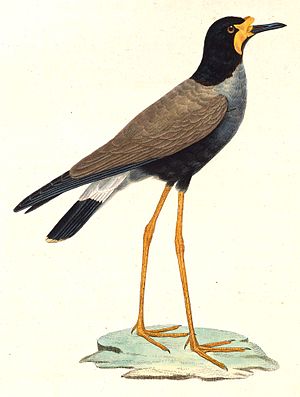Javakibitz
| Javakibitz | ||||||||||
|---|---|---|---|---|---|---|---|---|---|---|

Javan Pewter ( Vanellus macropterus ) |
||||||||||
| Systematics | ||||||||||
|
||||||||||
| Scientific name | ||||||||||
| Vanellus macropterus | ||||||||||
| ( Wagler , 1827) |
The Java lapwing ( Vanellus macropterus ), also known as the black-bellied lapwing , was a wader from Java . Alleged evidence from Sumatra and Timor has not been confirmed. It is believed to have died out today.
description
It reached a length of 28 centimeters. The head, throat, and neck were black. A long yellow wattled collar ran from the forehead over the base of the beak to the throat. The lower throat and chest were gray. The back and wings were light brown, but the wing feathers were black in color. The upper tail-coverts and the upper half of the tail were white. The rest of the tail was black with a tight white end band. The belly and thighs were black. The rump, under tail-coverts, under wing coverts and armpits were white. The eyes were black-brown. The beak was black but flesh-colored at the base. The legs were orange and the barrel was yellow.
distribution and habitat
The range of the Javakiebitz has not been properly researched to this day. There is only secure evidence from Java. The origin of one specimen and two eggs is unclear, but they could have come from Sumatra. Furthermore, three more specimens are said to have been sighted on Timor, which is, however, unconfirmed. Its habitat are steppe-like marshes in the river deltas in northern and eastern Java.
Way of life
Almost nothing is known about his way of life. During the rainy season, he stayed in the least flooded areas. It was also found on wet meadows (including on the pasture areas of the water buffalo), adjacent swamp areas with heavy sedge growth and low aquatic vegetation, and in open areas near ponds. It was presumably loyal to the location and performed in isolation in pairs in fairly spacious areas.
die out
Almost nothing is known about the reasons for its extinction. It was last sighted in June 1940 and then suddenly disappeared. In older literature there was often talk of merciless hunting. Presumably the main cause was the conversion of his habitat into arable land. In addition, one is not sure whether the Java kibitz is really extinct. It has been under nature protection since 1978. Due to the fact that large swamp areas of Java and the Sunda Islands have not yet been properly explored and an unconfirmed sighting from 2004, it is classified as critically endangered by the IUCN .
literature
- Errol Fuller (2000). "Extinct Birds", ISBN 0-8160-1833-2
Web links
- Vanellus macropterus in the endangered Red List species the IUCN 2008. Posted by: BirdLife International, 2006. Retrieved on January 25 of 2009.
- BirdLife Species Factsheet - Vanellus macropterus
- Information from the Zoological Museum Amsterdam